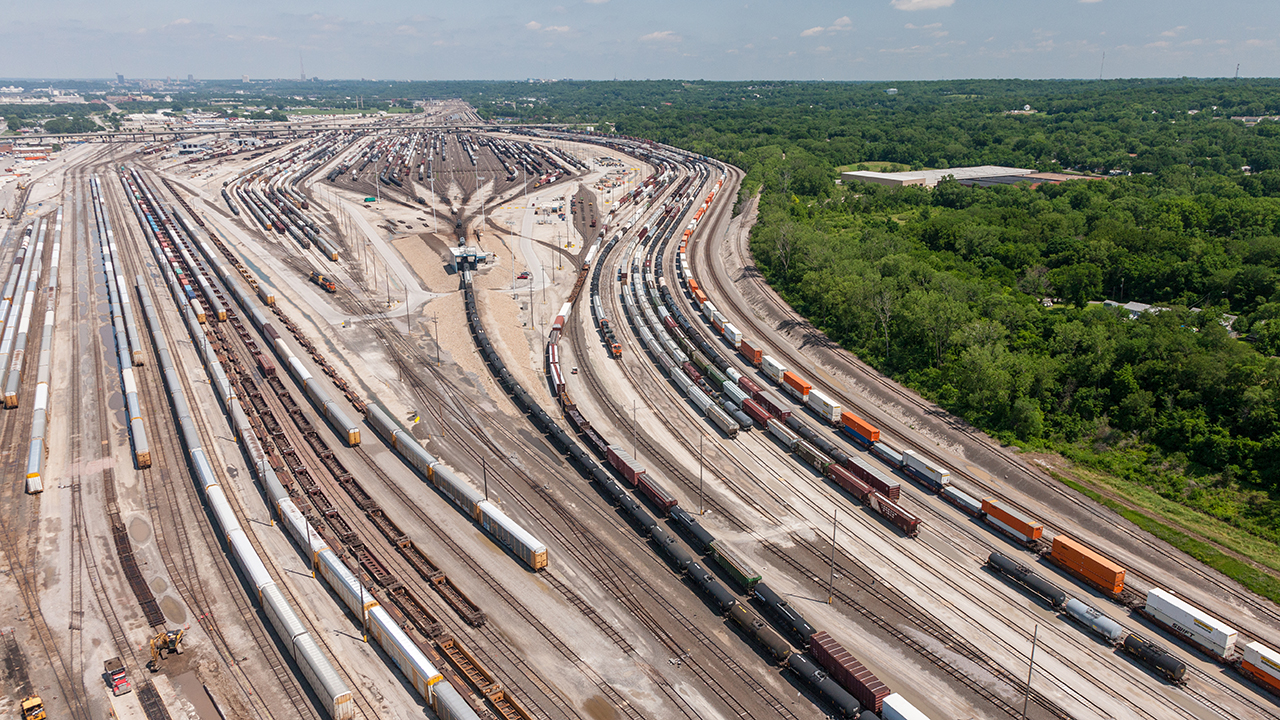
Innovation: Invisible to the Eye, Essential to Safety
Written by Gary T. Fry, Vice President, Fry Technical Services, Inc.; Railway Age Contributing Editor
Aerial view of the west end of Argentine Yard. BNSF photo
TIMEOUT FOR TECH, RAILWAY AGE JANUARY 2024 ISSUE: Modern railways are deeply innovative and dynamic systems. Despite this fact, I am frequently in conversations with people who wonder why “things never seem to change on the railroad.” They are surprised to learn the truth of just how changed and changeable railways really are! So, why the disconnect?
In my experience, it has a lot to do with what our eyes can see. For example, most people can clearly see the considerable differences between steam locomotives of the past and modern high-speed passenger trains. In contrast, however, the physical railways upon which modern locomotives run look much the same as railways from 150 years ago that supported steam locomotives. Is it possible that trains have improved, while the railways under them are the same?
Most railways still employ the basic concept of hard steel wheels rolling along two hard steel rails. Today’s rails still have a head, a web and a base. Timber ties remain very common. Broken-rock ballast layers are the norm for supporting the ties on a compacted and shaped roadbed of soil. Since “seeing is believing,” it does appear that railways haven’t changed much.
Our eyes deceive us! It turns out that some of the most important innovations in railroading are essentially invisible. One place comes to mind in particular: inside rails. Rails fail much less frequently today and last longer than ever under historically unprecedented demand—much heavier and more frequent axle loads.
These substantial gains in safety and performance are largely a result of enhanced metallurgy and improved manufacturing processes. Only under detailed examination in a metallurgy lab, using microscopes, can one see the differences between modern rails and those from decades past. Extraordinary and ingenious metallurgical and manufacturing innovations are simply unseen as we watch trains roll by!
There are other amazing innovations on the railway that often go unnoticed because they seem to be normal features alongside the tracks. Here, I’m referring to wayside detection systems. For example, intensely clever devices, protected within weather-worn metal boxes, identify wheels with geometric irregularities, such as missing tread pieces caused by the fast fracture of internal fatigue defects. There are similarly unremarkable metal containers for complex digital systems that identify bearings with thermal and/or acoustic anomalies that might indicate internal damage.
Further, with respect to wayside detection systems, there are dedicated organizational features—communications systems, digital archiving and computing systems, human resources, policies, procedures and more—necessary to process and respond to the wayside data streams that have no historical precedent in railroading. These essential back-office features are also not visible as we watch trains roll by.
It suffices to say that, despite some visual appearances, the modern railroad is substantially evolved and improved over its historic origins, especially in terms of safety, efficiency and reliability. And the improvement continues. As key innovations are developed and successfully implemented, the demand for more increases. But innovation on a railway is not for the faint of heart. It takes substantial commitment and effort. Let’s look at some of the features associated with innovative change on a railway.
When opportunities for innovation are identified and assessed, potential “challenges against change” must be also be identified and assessed—often a daunting process in a mature industry like the railway industry. Mature industries usually include dedicated organizations, such as technical societies and trade associations that publish essential standards, specifications, recommended practice guidelines, etc. Innovative changes in the industry often result in a need to revise these documents to avoid the innovation being interpreted as “out of line” in some way. Mature industries are often regulated, and revisions to federal regulations might also be needed before an innovation can be implemented fully and acknowledged officially as acceptable. Revising these documents in response to a desirable innovation can be a formidable “challenge against change,” and even the most promising innovations are at risk of falling by the wayside as a result.
Sections of these documents can be written in a style that facilitates, or even encourages, innovation or in a style that hinders innovation. As a result, revisions that render an innovation admissible might never be completed, might take several years to complete, or might not be required at all. Often, to support innovation, such documents avoid prescriptive phrasing to the maximum extent possible in favor of clearly stating performance requirements of the systems under consideration. Although some prescription is unavoidable, such as defining the measurement for standard gauge of a railway—56.5 inches (1,435 mm), the professionals who maintain these documents generally consider phrasing carefully to avoid creating unnecessary barriers to innovation.
In summary, with or without intent, mature industries generally have inertias to shift, in various types and amounts, before innovations can be fully implemented and effective. The inertias can be overcome by proving the merits of the innovation. The usual approach is to simply compare the performance of the innovation against the performance of the status quo. But here can be found another formidable “challenge against change.”
Imagine a situation where there is insufficient statistical data regarding the performance of the status quo. The innovation might be substantially and significantly superior to the status quo, but lacking the basis for comparison, the fact can’t be proved. The obvious answer is to gather the necessary data through controlled performance testing of the status quo. Sometimes this is straight-forward, other times it is not. For example, it can be especially difficult in an industry setting to obtain rigorous statistical assessments of human performance.
To be innovative, an organization must acknowledge that improvements are usually possible. There must also exist regular assessments of the organization’s operations with an eye to identifying opportunities for improving them. Innovative organizations are strategic in these assessments and always guided by their business models. The organizations establish and maintain an incentivized culture of innovation, especially in terms of intraorganizational communication and employee reward and promotion policies. With these conditions and policies in place, there is minimal inertia resisting progress, and the organization is receptive to innovation.
For more than 150 years, the railway industry has proved itself as being fundamentally innovative and committed to improving. As technology has advanced, the industry has kept pace, solved the “challenges against change” and continued moving forward. The innovative changes are not always flashy; sometimes they are invisible. But flash and change for the sake of change have never been part of the pragmatic railway equation. For the railway, changes are made to improve, and improvement should be measurable.
In this spirit, it is essential that railroads maintain a steadfast commitment to the “Five I’s”: Identify, Invest, Innovate, Implement, Improve!

Dr. Fry is Vice President of Fry Technical Services, Inc. He has 30 years of experience in research and consulting on the fatigue and fracture behavior of structural metals and weldments. His research results have been incorporated into international codes of practice used in the design of structural components and systems, including structural welds, railway and highway bridges, and high-rise commercial buildings in seismic risk zones. He has extensive experience performing in-situ testing of railway bridges under live loading of trains, including high-speed passenger trains and heavy-axle-load freight trains. His research, publication, and consulting have advanced the state of the art in structural health monitoring and structural impairment detection.



